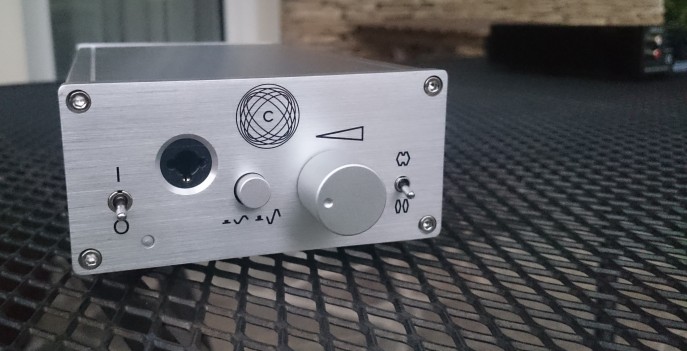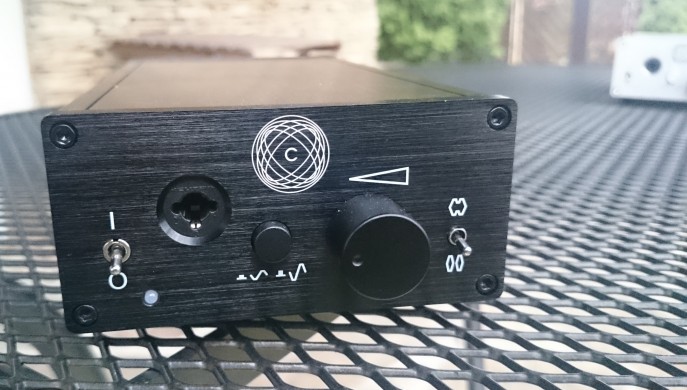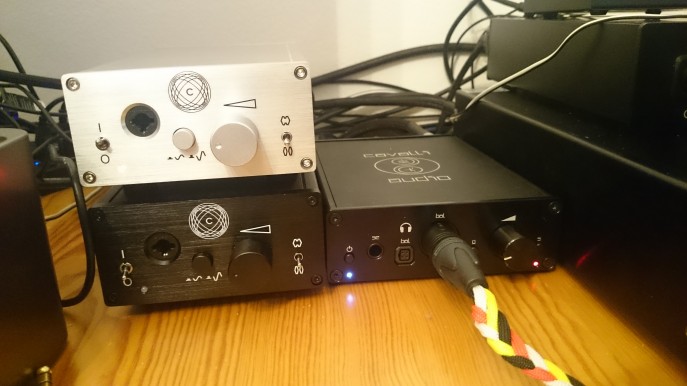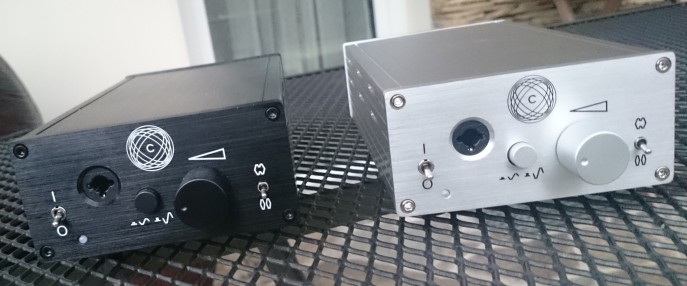I first met Jan Meier last year at an audiophile gathering in Germany. He was one of the friendliest and most outgoing people I met there and he invited me to listen to some of his bigger amplifiers, namely the Corda CLASSIC and Corda DACCORD. I thought what I heard sounded very promising and so indeed a few weeks ago, I asked him for something to review. He instead offered me two of his lower priced amplifiers, which he thought were underappreciated, considering their capabilities and price. And so I agreed and a few days later, the JAZZ and JAZZ-ff landed on my doorstep.
As I opened the shipping box, it was quite apparent that no unnecessary expenses were spent on packaging. Each amplifier was packed inside a small cardboard box, held securely in place by a styrofoam cutout. Accessories include an owner’s guide, containing all the necessary information you might want to know and a power cord. That’s it. Considering the price range, a no-frills packaging seems adequate and if it is what helped to push the price down further, then the better.
Overall design & build quality are in one word – stellar. The compact body as well as every moving part is made from anodized aluminum, with color choices including black (blue LED) and silver (red LED). There is an on/off flick switch, gain settings button and a ¼ headphone out on the left and an electronically controlled volume pot, along with crossfeed settings (more on that later) on the right side of the front plate. The Corda logo proudly meets them square in the middle. On the back we are greeted by an RCA input, along with a standard 3-prong power socket in. Vents are on the sides and bottom, helping the aluminum body dissipate heat. The amplifier’s back plate can be removed to switch the voltage settings or change the fuse in case of shorting. Externally, there is very little that sets the ff and non-ff versions apart as they are made from the exact same body parts. To differentiate between them, there is a label on the bottom of each unit which states whether it is the ff version or not. There are no balanced connections to be found here. I have had zero qualms with the build to this point and since each unit feels equally rock solid, I am sure they are ready to provide listening enjoyment for hours on end.

For music listening, I exclusively used my current champion, the HiFiMAN HE1000, which while not perfect, has been one of my most enjoyed headphones. It is a colored headphone however, which means it does not play well with everything. It requires fairly neutral gear, without any peaks in the lower treble or additional colorations in the bass region. The even-sounding JAZZ had no problem driving it and I scarcely went above 9 o’clock on the pot with high gain engaged.
In terms of sound reproduction, both amplifiers produce a neutral, transparent and dynamic sound, suitable for a wide range of headphones, from fairly warm to slightly bright. I would classify the soundstage as moderately large, with very even width and depth, able to produce a fairly holographic soundscape. Instruments are placed evenly with minimal congestion even during busy passages. Treble is well extended, neither rolled-off nor overly present, and does not emphasize peaks, producing clear cymbal crashes just as well as secondary harmonics of other instruments, like violins and pianos. Transition to the midrange is fairly smooth but not smoothed over in the least, with good energy without excessive sibilance bursts. Midrange has good body and presence without sounding neither thin nor harsh, lacking any extra bloom or syrupiness. Transition to lower midrange and bass is very good, producing satisfying guitar riffs and grunts. Bass has great presence throughout and is reasonably tight, without any midrange bloat. I could not perceive any dips or peaks in the whole bass region. In terms of what I have available, I ranked this amp dead neutral but far from lifeless or flat, suitable for most genres. With the HE1000, I think it performed very well and did not highlight any flaws, even though it does not add any extra warmness that I would appreciate to tame its low treble peak.
Now, where the two differ is the ff technology, or “Frequency Adaptive Feedback”. What it does is “reshape” the input and the feedback signals in exactly the same way, using two equalization stages, emphasizing the high frequency components. The results should be an improvement in the definition of the middle and upper frequencies. The sound should become more fluent and better defined. Micro-detail should also be enhanced. I mostly agree with this statement as I found the high frequencies clearer (not necessarily sharper), more refined, which resulted in slightly bigger soundstage, better attack and more precise imaging. The additional clarity did make micro detail easier to perceive. As such, the regular non-ff JAZZ ended up sounding a bit muddier, slightly less energetic and dynamic, with soundstage not as expansive. This less focused presentation amounted for a slightly smoother, less airy sound and what I perceived as slightly more bass body due to reduced energy in the treble. The ff version is 20% more expensive than the ff-less version. While the differences are not super profound, the ff sounds more accurate and technically more proficient. The non-ff is better suited for those who prefer a more relaxed presentation or poses bright gear with a desire to tame it. Either way, neither will disappoint you. I found them both to perform beyond what I expected based on their relatively inexpensive price. You can also upgrade to the ff version at any time for 100€/115$, by shipping it to Meier Audio.
There is one additional advantage to these fine amps, as both JAZZes and all higher priced Meier units come with the ‘natural’ crossfeed function. A time delay and a degree of attenuation is applied to off-center sounds while sounds in the center are left untouched. The more away from the center a sound is, the more attenuation and delay is applied. The resulting sound does not really feel artificial, instead introducing a different presentation of sorts. I found the soundstage to be leveled up a bit and all the “headphone echo” removed, producing a drier, clearer response. For example, a guitar normally sounds locked into the left cup. The crossfeed moves it slightly higher and removes the “headphone cup” echo, making it sound more like a speaker would. I did spend more time listening without crossfeed as it made it easier to compare. Whether one would prefer the sound with or without the CF filter is a very personal matter and a clear toss-up. This feature is incredibly useful with older recordings however, where the hard L-R panning is significantly reduced when crossfeed is engaged. I do see it as a handy and well-implemented bonus that offers a different experience compared to traditional headphone sound.

Then, I also compared them to other, similarly priced amplifiers:
Vs the Cavalli Liquid Carbon (599$) – The Carbon has the warmest tonality of all amplifiers compared here. It carries bigger, more impactful tones. I would match it with neutral or bright headphones. It sounds the most natural and richest, slightly reminiscent of tubes, pumping out lots of musicality. A bold, impactful and engaging signature. The soundstage is on the intimate side, with decent depth but only average width. It has the smoothest treble, lacking a bit of extension up top. This smoothness is carried to the midrange, where it once again lends the most body to instruments and voices. It has a very enveloping quality that puts you right up on stage with your favorite band. Lower midrange especially deserves lots of praise for its excellent portrayal of guitar riffs. The bass has a thick presence, with more oomph and punch than the other offerings here. Its smooth yet forward character makes smaller scale recordings sound excellent. However, once things get busy, the LC-HE1000 pairing loses composure as some instruments get pushed back due to the now apparent warmness-induced congestion. This little amplifier tries to put all the good stuff on the forefront but because the soundstage is now rather narrow, it simply can’t fit it all in. The tonality is often excellent as it gives vocals great presence and helps to even out the treble peak nicely, but the bass can get overbearing, and as a reason the soundstage suffers.
I would only recommend the HE1000 – LC pairing if you listen to jazz, other less complex music or if you place musicality above all. Put against the more neutral JAZZes, it becomes apparent, at least to my ears, that this particular pairing did not match very well and the more complex the music got, the more it was technically outclassed in certain aspects, including soundstage size, treble extension, separation and detail retrieval. However, I wholeheartedly recommend the Liquid Carbon for brighter headphones like HiFiMAN’s own HE-560, the Sennheiser HD800 or Beyerdynamic’s T1, where I feel the resulting sound would be excellent. As it showed in many aspects, I do think it is an excellent amplifier that just did not mate very well with HiFiMAN’s latest flagship, proving that the warm + warm = greatness formula does not always work.Vs the Audio-gd SA31SE – I have owned the SA31 for a couple of years now and I long considered it to be on the warmer, more musical side. Well, with the JAZZ and LC in house, I stood corrected. It is the brightest of the amps compared here, recommended for warm to neutral headphones. It is also technically the most proficient. It has the best soundstage width, treble extension and sense of air. Other strengths include attack, separation, imaging and detail retrieval. It would be a perfect match for the HE1000 if it did not expose the lower treble peak more than the other offerings. It also makes its bass a bit too tight and slightly on the soft side. Just like the Liquid Carbon I recommend it for other headphones, but in this case it would be the likes of Audeze and Oppo. This amplifier gave me many jaw-dropping moments in the past and I hope it will give me many more with different headphones in the future.

The regular JAZZ retails for 345€ (295€/325$ outside EU) while the ff version retails for 425€ (365€ / 405$ outside EU), which is at least a 1/3 cheaper than all the other amplifiers I tested here, some of which it even managed to outperform in various aspects. It is also worth noting that the price includes worldwide shipping. I was fairly skeptical about the JAZZes and did not think they would be something special, considering the price and the availability of more expensive offerings from Meier. But I was pleasantly surprised. Not only is it crammed to the brim with electrical components and sophisticated devices, but it also offers extra features like cross-feed . Above all, it provides lots of clean power that can power all but the world’s most power hungry headphones. With a well-balanced signature and a price to beat, I have absolutely no hesitation to recommend either of the Meier Audio amplifiers to those looking for a bang for their buck.
Technical specifications:
Dimensions: 22.2 x 10.6 x 6cm
Weight: 1kg
Power supply: 120V / 240V, selectable
Power draw: 5W
Gain: 0 / 16dB (low / high)
Volume control: 31 steps (by 1.4dB increments)
Maximum output voltage / current: 15V / 300mA/channel
Output impedance: < 0.1 Ohms
Disclosure:
Lukas Vokrinek is affiliated with Cavalli audio as of 3/18/2016 after his article was written for Headphone Guru. It is out policy to not publish any articles from writers employed or affiliated with any manufacture to avoid any conflicts. Since it was written before the affiliation we decided to publish this will be the writers final article for Headphone Guru due to industry affiliation.















Want to join discussion?
Feel free to contribute!